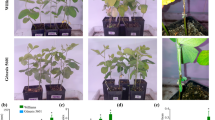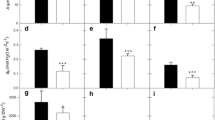Abstract
Soybean [Glycine max (L.) Merr] plants were exposed to three temperature regimens during seed development to investigate the effect of temperature on the expression of eight defense-related genes and the accumulation of two fungal pathogens in inoculated seeds. In seeds prior to inoculation, either a day/night warm (34/26°C) or a cool temperature (22/18°C) relative to normal (26/22°C) resulted in altered patterns of gene expression including substantially lower expression of PR1, PR3 and PR10. After seed inoculation with Cercospora kikuchii, pathogen accumulation was lowest in seeds produced at 22/18°C in which of all defense genes, MMP2 was uniquely most highly induced. For seeds inoculated with Diaporthe phaseolorum, pathogen accumulation was lowest in seeds produced at 34/26°C in which of all defense genes, PR10 was uniquely most highly induced. Our detached seed assays clearly demonstrated that the temperature regimens we applied during seed development produced significant changes in seed defense-related gene expression both pre- and post inoculation and our findings support the hypothesis that global climate change may alter plant–pathogen interactions and thereby potentially crop productivity.


Similar content being viewed by others
References
Aguilar F, Montandon PE, Stutz E (1991) Two genes encoding the soybean translation elongation factor eEF-1 alpha are transcribed in seedling leaves. Plant Mol Biol 17:351–360
Byfield GE, Upchurch RG (2007) Effect of temperature on delta-9 stearoyl-ACP and microsomal omega-6 desaturase gene expression and fatty acid content in developing soybean seeds. Crop Sci 47:1698–1704
Doehlert DC, Wichlow DT, Gardner HW (1993) Evidence implicating the lipoxygenase pathway in providing resistance to soybeans against Aspergillus flavus. Phytopathology 83:1473–1477
Du L, Ali GS, Simons KA, Hou J, Yang T, Reddy ASN, Poovaiah BW (2009) Ca2+/calmodulin regulates salicylic-acid-mediated plant immunity. Nature 457:1154–1159
Garrett KA, Dendy SP, Frank EE, Rouse MN, Travers SE (2006) Climate change effects on plant disease: genomes to ecosystems. Annu Rev Phytopathol 44:489–509
Hou G, Ablett GR, Pauls KP, Rajcan I (2006) Environmental effects on fatty acid levels in soybean oil. J Am Oil Chem Soc 83:759–763
Kachroo A, Kachroo P (2009) Fatty acid-derived signals in plant defense. Annu Rev Phytopathol 47:153–176
Kachroo A, Venugopal SC, Lapchyk L, Falcone D, Hildebrand D (2004) Oleic acid levels regulated by glycerolipid metabolism modulate defense gene expression in Arabidopsis. Proc Natl Acad Sci USA 101:5152–5157
Malamy J, Hennig J, Klessig DF (1992) Temperature-dependent induction of salicylic acid and its conjugates during the resistance response to tobacco mosaic virus infection. Plant Cell 4:359–366
Moniz de Sa M, Drouin G (1996) Phylogeny and substitution rates of angiosperm actin genes. Mol Biol Evol 13:1198–1212
Pfaffl MW, Horgan GW, Dempfle L (2002) Relative expression software tool (REST) for group-wise comparison and statistical analysis of relative expression results in real-time PCR. Nucleic Acids Res 9:e36
Rajcan I, Hou G, Weir AD (2005) Advances in breeding of seed-quality traits in soybean. J Crop Improv 14:145–174
SoyStats (2011) American Soybean Association, St. Louis. Available at http://soystats.com
Sugimoto T, Kawasaki T, Kato T, Whittier RF, Shibata D, Kawamura Y (1992) cDNA sequence and expression of a phosphoenolpyruvate carboxylase gene from soybean. Plant Mol Biol 20:743–747
Szittya G, Silhavy D, Molnár A, Havelda Z, Lovas Á, Lakatos L, Bánfalvi Z, Burgyán J (2003) Low temperature inhibits RNA silencing-mediated defence by the control of siRNA generation. EMBO J 22:633–640
Tang G-O, Novitzky WP, Griffin HC, Huber SC, Dewey RE (2005) Oleate desaturase enzymes of soybean: evidence of regulation through differential stability and phosphorylation. Plant J 44:433–446
Upchurch RG, Ramirez ME (2010) Defense-related gene expression in soybean leaves and seeds inoculated with Cercospora kikuchii and Diaporthe phaseolorum var. meridionalis. Physiol Mol Plant Pathol 75:64–70
Van Loon LC, Rep M, Pirterse CMJ (2006) Significance of inducible defense-related proteins in infected plants. Annu Rev Phytopathol 44:135–162
Vandesompele J, De Preter K, Pattyn F, Poppe B, Van Roy N, De Paepe A, Speleman P (2002) Accurate normalization of real-time quantitative RT-PCR data by geometric averaging of multiple internal control genes. Genome Biol 3:1–12
Wang Y, Bao Z, Zhu Y, Hua J (2009) Analysis of temperature modulation of plant defense against biotrophic microbes. Mol Plant Microbe Interact 22:498–505
Wolf RB, Cavins J, Kleiman R, Black LT (1982) Effect of temperature on soybean constituents: oil, protein, moisture, fatty acids, amino acids, and sugars. J Am Oil Chem Soc 59:230–232
Wrather JA, Sleper DA, Stevens WE, Shannon JG, Wilson RF (2003) Planting date and cultivar effects on soybean yield, seed quality, and Phomopsis sp. seed infection. Plant Dis 87:529–532
Xue HQ, Upchurch RG, Kwanyuen P (2008) Relationships between oleic and linoleic acid content and seed colonization by Cercospora kikuchii and Diaporthe phaseolorum. Plant Dis 92:1038–1042
Yang S, Hua J (2004) A haplotype-specific resistance gene regulated by BONZAI1 mediates temperature-dependent growth control in Arabidopsis. Plant Cell 16:1060–1071
Acknowledgments
We thank the staff of the Southeastern Plant Environmental Laboratory at North Carolina State University for growth chamber space. Mention of trade names or commercial products in this article is solely for the purpose of providing specific information and does not imply recommendation or endorsement by the U.S. Department of Agriculture.
Author information
Authors and Affiliations
Corresponding author
Rights and permissions
About this article
Cite this article
Upchurch, R.G., Ramirez, M.E. Effects of temperature during soybean seed development on defense-related gene expression and fungal pathogen accumulation. Biotechnol Lett 33, 2397–2404 (2011). https://doi.org/10.1007/s10529-011-0722-5
Received:
Accepted:
Published:
Issue Date:
DOI: https://doi.org/10.1007/s10529-011-0722-5




